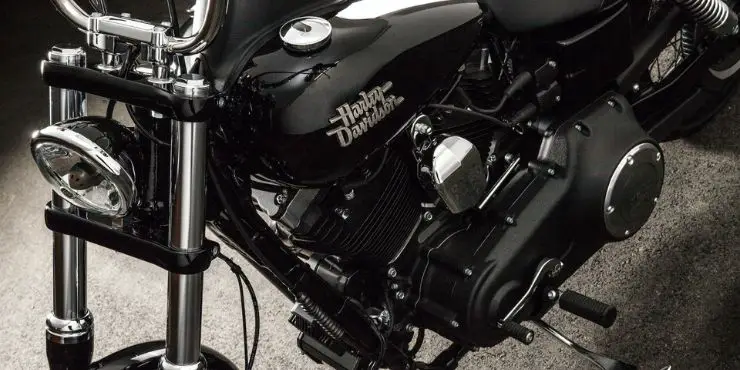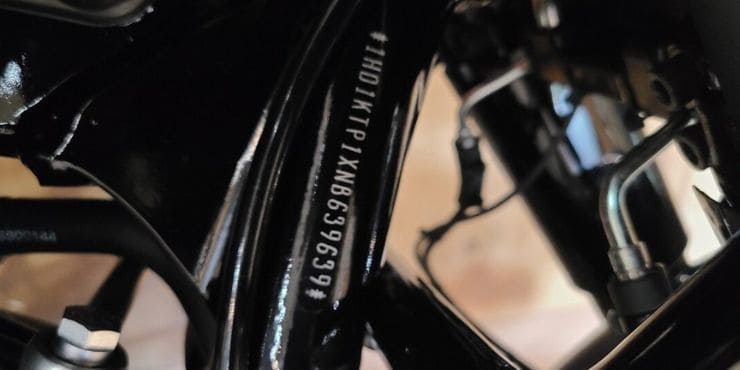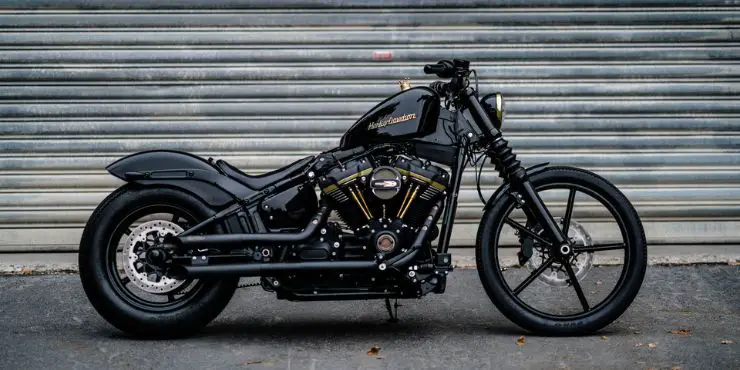Are you looking to buy a Harley-Davidson bike but want to check out a few details using the VIN number but don’t know much about it? Don’t worry, by the time you’re done reading this post, you’ll know a lot about the VIN number on a Harley-Davidson bike.
The VIN number on a Harley-Davidson is located on the frame, typically near the steering head. Some models may also have it stamped on the engine.
In this article, you’ll get to know all about the VIN codes, where is the VIN number on a Harley-Davidson motorcycle, how you can decade over a century worth of VIN codes, and more. Continue reading to get all the answers that you’re looking for.
What is a VIN code for Harley-Davidson bikes?
The Vehicle Identification Number or VIN can tell you as much information about a bike as the DNA of a human being. Whether you’re taking the help of a VIN decoder or you know how to decide the VIN yourself, you’ll be able to find out all the technical specifications of your body. You can know about the engine type, the body of the bike, and other equipment that comes with the motorcycle. The Harley-Davidson bikes can be divided into three different groups, depending on the manufacturer date and the way the VIN codes are deciphered.
1930 to 1969
The first category is the bikes that were produced between 1930 and 1969. The VIN code consisted of 8 characters. The first two numbers signified the manufacturer year, the next two were for the model, and the last portion was the production number.
1970 to 1989
The second category involves the bikes that were manufactured between 1970 and 1980. The VIN code during this era had 9 characters. The code featured information such as the model, the production number, and the year.
1980 to current
The third category involves the Harley-Davidson bikes that have been in production since 1980. The VIN code in these bikes will be located on the frame. It normally consists of 17 characters, and they can be deciphered with a Harley-Davidson VIN decoder.
Where is the VIN number on a Harley-Davidson motorcycle?
Before knowing anything about the VIN code, you’ll need to know where is the VIN number on a Harley-Davidson motorcycle. If you’re riding a Harley-Davidson bike manufactured in 1969 or before, the VIN code will be located on the motor. It’ll be hand-stamped on the left-hand side of the motor case, under the cylinders on the raised boss. It is important to note that the VIN codes weren’t stamped on the frame during those days. Any numbers found on the frame are actually casting numbers that are identical on every frame of the same year/model.
Beginning in 1970, the official VIN location moved from the motor to the frame neck. It has remained this way ever since. Between 1970 and 1980, Harley-Davidson continued stamping a matching VIN on the motor (except for the models manufactured in 1979. The motor can be matched to the frame. In 1981, the company switched to the 17-digit VIN standard. Moreover, it also stopped stamping a VIN on the motor and started using a truncated version of the VIN on the motor. This allowed for matching the motor to the frame while only using 10 digits.

Whether you’re scouring the market for rare bikes, checking out information for your used bike, or need some info about a bike you saw in the parking lot, a VIN can help in all cases. Understanding how different VIN formats work will give you the needed info on what type of bike you’re looking for. From the start, Harley-Davidson has been stamping its engines with unique serial codes. However, the early serial numbers didn’t actually conform to any standard until the 1920s. Then, Harley-Davidson started using an easily decipherable string of numbers and letters that continued to be in use until 1969.
For the 1970 models, Harley-Davidson revamped its VIN numbers and for a 10-year period, the brand used a different arrangement. The last change actually arrived in 1981, when the National Highway Traffic Safety Administration mandated that manufactured vehicles adopt a 17-digit VIN. Then, Harley-Davidson switched to the new standard, which is still in place today.
Decoding over a century of Harley-Davidson VIN codes
Harley-Davidson VIN numbers before 1970
Returning to the 1920s, Harley-Davidson standardized on a fairly straightforward format for the VIN codes. Through 1969, Harley-Davidson VIN codes consisted of a combination of 8-11 numbers and letters with the following arrangement –
- The first two characters signified the production year
- The next 1-4 characters specified the model
- The remaining 4-5 characters specified the production number
Further, breaking down the VIN code, you’ll find that the majority of the information about an individual bike is contained within the letters after the production date. The first letter is commonly referred to as the engine code. It designates the type of motor that was originally installed at the factory. There will be different engine codes for Harley-Davidson V-twin motors that were built from 1920 until 1969.
Before 1935, Harley-Davidson produced a wide variety of single-cylinder models under engine codes A, B, and C. There were also two horizontally opposed two-cylinder motors under engine codes WF and WJ. There were other horizontally opposite two-cylinder motors built in 1942, and it was specified by the letters XA.
Harley-Davidson did a wonderful job of assigning different letter designations to each variety of side valve motor. They also started overlapping when they switched to overhead valve motors for the big twin models. Hence, you’ll need to know the date ranges for different types of early overhead valve motors. This way, you will know a set of 1947 EL cases go to a knucklehead whereas a set of 1948 EL cases went to a Panhead.
Any letters after the engine code will tell more specifics regarding the motor. They can indicate a special model, such as A for Army or R for factory racer. Usually, it tells a lot about the engine’s performance as compared to the base motor. For instance, a standard U series motor is 74” with medium compression heads. Based on this motor, Harley-Davidson built three different versions, which were designated the UH, the ULH, and UL. The UH is a larger displacement version of the base motor, which bumps the cubic inches to 80” and keeps the medium compression heads.
The UL featured a similar displacement as the base motor, but it was outfitted with high compression heads. The ULH is a combination of the UL and UH motor, and it features the 80” and high compression heads.
Unfortunately, Harley-Davidson kept on changing the meanings of the letters over the years to fit with the model lineups. If you look at the model designations for early Panheads, you will find that there is indeed a medium compression 74” base motor that is designated with the letter F. There is also an FL model with a 74” motor and higher compression.
For any model year before 1970, if you look at the actual production numbers from Harley-Davidson, you’ll see that there are many models listed that use unconventional letters. That is because Harley-Davidson didn’t actually include these letters in the VIN numbers. While Harley-Davidson might have produced FLF and FLHF in 1957, for instance, these motorcycles would have haven stamped FL ad FLH respectively with the F omitted. Some other examples of omitted letters are B for electric start and S for the sidecar.
The last piece of the puzzle was the production number. It should come as no surprise that Harley-Davidson added a few twists to that, too. Until 1961, the production numbers would always start at 1000. It meant that the first EL Panhead coming off the line in 1948 would have had 48EL1001 instead of 48EL0001. Between 1962 and 1969, Harley-Davidson decided to switch things up slightly. The brand made the first digit of the production number odd on odd model years and even on even model years for the 4-digit production numbers. Taking things a step further, on 5-digit production numbers, the first two numbers were odd for odd mode years and even for even model years.
Harley-Davidson VIN numbers between 1970 and 1980
1970 saw Harley-Davidson changing the VIN numbers to a 9-digit combination of numbers and letters, with this arrangement.
- The first 2 characters signify the model code
- The next 5 characters signify the production number
- The last 2 characters signify the year code
As mentioned previously, 1970 marked the first year that the first official VIN location got moved to the frame neck. However, there was still a matching VIN number stamped on the motor. The first month of 1979 saw Harley-Davidson deciding to put unique, non-matching VIN numbers on the motor and frame neck. Due to complaints from the police and the bikes being stolen, this practice only lasted until production numbers 43000H9 – 48199H9.
Harley-Davidson VIN numbers from 1981 to present
Starting in 1981, Harley-Davidson implemented a new 17-digit VIN number format mandated by the National Highway Traffic Safety Administration. The full VIN code got stamped on the frame neck, while a shortened 10-digit version was stamped on the engine. The 17-digit VIN code uses the following arrangement –
- The first three characters specify the manufacture ID
- The fourth character specifies the weight class ID
- The fifth and sixth characters specify the model code
- The seventh character specifies the engine code
- The eighth character specifies the introduction period
- The ninth character specifies the VIN check digit
- The tenth character specifies the model year code
- The eleventh character specifies the assembly plant code
- The final six characters specify the production number
(1-3) First three characters
The first three characters are used to denote the world manufacturer ID. These characters indicate where the bike was manufactured and intended for sale. There are four codes that you can possibly see in this spot. For VINs that show “1HD”, it’ll indicate that the bike was manufactured for sale in the United States. If it reads “5HD”, then it means that the bike was manufactured to be sold outside of the United States. If the VIN code reads “932”, the bike was manufactured in and for sale only in Brazil. If it reads “MEG”, then it means that the bike was manufactured in and for sale in India exclusively.
(4-8) Four to eight characters
The fourth to eighth characters are used for identifying the engine type, engine size, and the bike’s model. This is the part that will help you determine critical information on the mechanical details of the bike.
The fourth character will be either “1”, “4”, or “8”. “1” is used for a heavyweight 901cc or large motor, “4” for a lightweight or middleweight 351-900cc motor, and “8” for a sidecar.
The fifth and sixth characters are letters, and they indicate model designation for the bike. It’ll help you identify if the bike is an FLT, Dyna, Softail, or XL model. There are many charts available online that’ll give you a breakdown of every possible model and its assigned VIN code. However, a general rule of thumb is that “D” is for FLT (Touring) models and “B” is for Softail bikes. Meanwhile, “C” is used for XL models. There are a couple of exceptions to these rules. The FLHR Road Glide lineup uses “FD” instead of “D” while the Dyna Bad Boy uses “BN” and falls under the Softail sequence.
The seventh character signifies the engine displacement of the bike. The possible letters that you will see here, and the engine identified, include –
- L – Carbureted 1340 EVO
- R – Fuel-injected 1340
- M – 883 Evolution
- N – 1100 Evo
- P – 1200 Evo
- V – Carbureted TC88
- W – Fuel-injected TC88
- Y – Carbureted TC88B
- B – Fuel-injected TC88B
The eighth character is used to signify how the motorcycle model was introduced. It indicates whether the model was a standard rollout (1), a mid-year release (2), a California-only bike, or a Special Edition release (4). Other characters can also exist in this spot if the motorcycle is sold internationally. These characters are rather unique to the specification of where the bike is manufactured and is intended for sale.
(9) Ninth character
The ninth character acts as the validator or checks digit for the VIN code. There are no references or secondary codes for this check digit, as it’s merely for validation purposes.
(10) Tenth character
The tenth character of the VIN code indicates the model year of the motorcycle. The years 1980 to 2000 are denoted by alphabets, beginning with “A” for 1980, “B” for 1981, and so on, ending with “Y” for 2000. After 2000, it has been changed to numbers. The sequence started with letters again in 2010 with “A” denoting the model year 2010. Remember, the characters O, Q, U, Z, and I and the number 0 are not used in VIN codes.

(11) Eleventh character
The eleventh character is the factory code, and it denotes the manufacturing plant that particular bike was manufactured. Within the United States, the letters “B” and “Y” indicate that the bike was assembled in York, Pennsylvania. Meanwhile, the letter “E” signifies assembly at the Buell Plant in East Troy, Wisconsin. The letter “T” signifies the plant located in Tomahawk, Wisconsin. The letter “J” signifies the plant location in Milwaukee, Wisconsin, whereas “K” is used for referencing the plant located in Kansas City, Missouri.
Outside of the United States, the two letter used commonly are “N” and “D”. The letter “N” is used for bikes assembled at the plant in Haryana, India, while “D” is used for the Harley-Davidson plant in Manaus, Brazil. If there is any other character in this position, it indicates the bike was assembled at a plant in Thailand.
(12 – 17) Twelfth to seventeenth character
The last six characters of the VIN act as the unique serial number. These characters are specific to the particular unit of the motorcycle.
Conclusion
Thank you for reading. Hopefully, now you know a lot more about the VIN codes, where is the VIN number on a Harley-Davidson motorcycle, how you can decade over a century’s worth of VIN codes, and more. The Vehicle Identification Number or VIN Code on a Harley-Davidson motorcycle is equivalent to the DNA of a human being. The VIN contains the necessary information about the past and present of the bike. The VIN code is mentioned on the frame neck of the bike, and it has been this way since the 70s. In the vintage bikes built before that, the VIN was also located on the motor.

